History of the DIII-D Tokamak
A device to develop fusion solutions
History of DIII-D
DIII-D is the fourth machine in a line of fusion research at General Atomics (GA) that began in the 1950s. As the largest and most expansive magnetic fusion research program in the United States, DIII-D represents a major evolution built on the breakthroughs achieved with the preceding GA doublet devices. Today, the work at the DIII-D National Fusion Facility advances our understanding of plasma physics and optimizes the tokamak approach to fusion energy production.
Construction of the first device in this series began in 1957, and in 1968, scientists at GA completed this magnetically-confined toroidal plasma device with a figure–eight cross–section, named Doublet I. Instead of employing the circular cross–section used in tokamak devices at the time, the plasma was confined in a doublet shape, which was predicted to create high fusion performance by sustaining higher plasma pressure. As predicted, the performance of Doublet I provided sufficient scientific evidence to justify the development of a larger device.
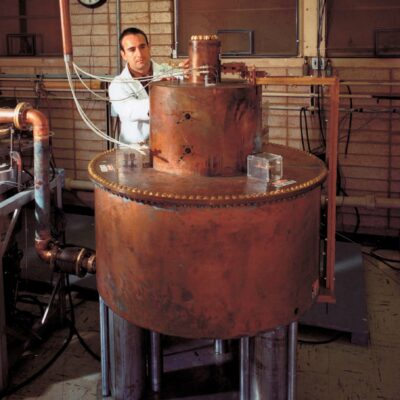
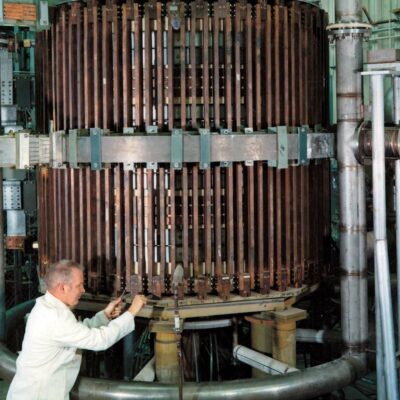
Using the same doublet concept, the aptly-named Doublet II tokamak was built to compete with similarly-sized tokamaks around the world; it was completed in 1971. This tokamak went on to generate stable plasmas for tens of milliseconds with a plasma pressure metric (known as plasma beta) that was higher than that achieved in other contemporary tokamaks at the time. In 1974, the device’s vacuum vessel was upgraded to use magnetic coils to establish the plasma shape, rather than relying on passive shaping from the contours of the vacuum vessel. Experiments on the upgraded “Doublet IIA” pioneered active plasma control via external coils and helped inform the modern methods of plasma control used today.
Based on the success of Doublet II/IIA, GA started designing a new, larger machine that would function as a critical test of the doublet concept. Notably, flexibility was a key priority early on, as the need to modify and improve the machine over time had already become apparent.
Funded by the U.S. Department of Energy (and later supported in-part by the Japan Atomic Energy Research Institute), Doublet III started operations in 1978 as the largest magnetic confinement facility in the world. The device quickly went on to set the record (at the time) for the highest plasma current ever achieved at 2.2 million amperes. A 1979 cooperative funding agreement with the Japan Atomic Research Institute facilitated upgrades to Doublet III’s power equipment and added additional neutral beam heating sources. By utilizing the machine’s shaping coils, scientists from GA and Japan investigated different plasma configurations and their impacts on stability, control, and performance. One configuration, which utilized a “D-shaped” plasma confined to the top half of the doublet-shaped vessel, showed significant promise.
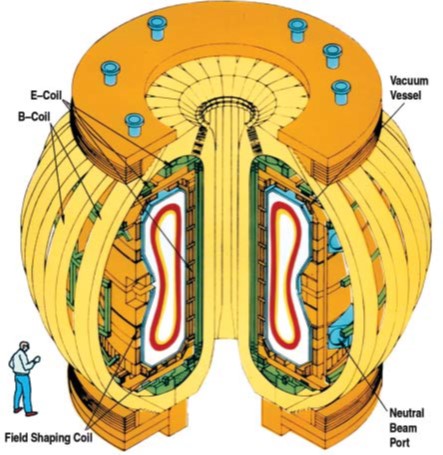
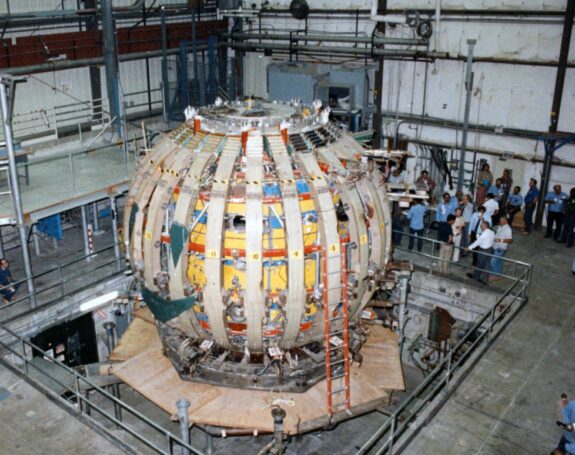
While Doublet III was designed around the doublet concept, the studied D-shaped plasmas were easier to generate and maintain, as well as thought to be more applicable to a power plant. This simplified plasma shape also achieved the higher pressures necessary for high-performance plasma (higher plasma beta values). After a successful campaign of experiments involving 50,000 plasma discharges in the D-shaped configuration, the United States Atomic Energy Commission selected GA to replace the doublet-shaped inner walls of Doublet III with larger D–shaped inner walls, referred to at the time as the “Big Dee.” This new device started operations in 1986 as “DIII-D” (a nod to the “Big Dee” evolution) with a renewed, ambitious research mission.
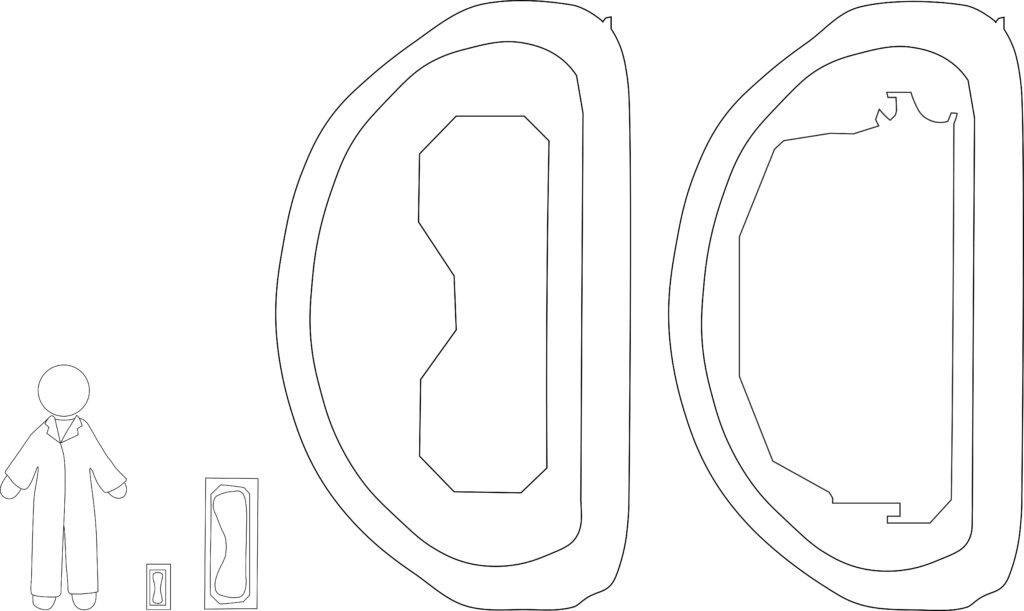
Over the years, DIII-D has made numerous major contributions to tokamak fusion energy research and has undergone continuous upgrades to stay on the cutting-edge of the field. Some notable accomplishments are included below:
-
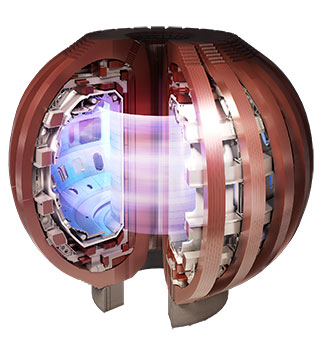
Artist’s rendering of the DIII-D vessel today. A set of scaling laws that allowed scientists to make performance projections for other tokamaks (both those existing at the time and those built since then) were developed in the late 1980s and early 1990s based on work done on DIII-D.
- Discovery of the high-confinement mode (or “H-mode”) at the ASDEX tokamak, which exhibited significantly longer confinement than the existing “L-mode” scenarios at the time, opened up an entirely new area of research at DIII-D. Optimizing the shape and characteristics of the plasma enhanced performance even further by achieving a very high plasma pressure (as measured by the plasma beta value). Based on this approach, DIII-D coined the “advanced tokamak” concept in the early 1990s, which has since become a major area of fusion research focused on developing the science to design a commercial power plant. By maintaining the same performance at lower current, researchers also found that this approach could enable steady-state operation.
- A software platform was developing in the early 1990s to control the shape and position of the DIII-D plasma in real-time. This plasma control system (PCS) has since been upgraded regularly, taking advantage of advancements in computer hardware to improve plasma performance and expand its control capability. The PCS is now used globally on many different fusion devices for various research needs.
- In the late 1990s and early 2000s, a type of H-mode scenario free of transient events, referred to as quiescent H-mode or QH-mode, was discovered on DIII-D. This mode offers the long confinement times of H-mode operation without the periodic transient events that disturb the plasma state and impart significant damage to the surrounding wall.
- In the 2000s, DIII-D pioneered the use of resonant magnetic perturbations (RMPs) to control transient events in the plasma. These techniques have since been utilized in tokamaks around the world to reduce the detrimental effects of transient events on the plasma and the surrounding wall.
- Diagnostic development has consistently been a major component of the research program at DIII-D, and DIII-D is the best diagnosed machine in the world. Collaborators from around the world have built, installed, and upgraded diagnostic systems that provide useful research data for DIII-D and inform diagnostic solutions for next-generation devices.
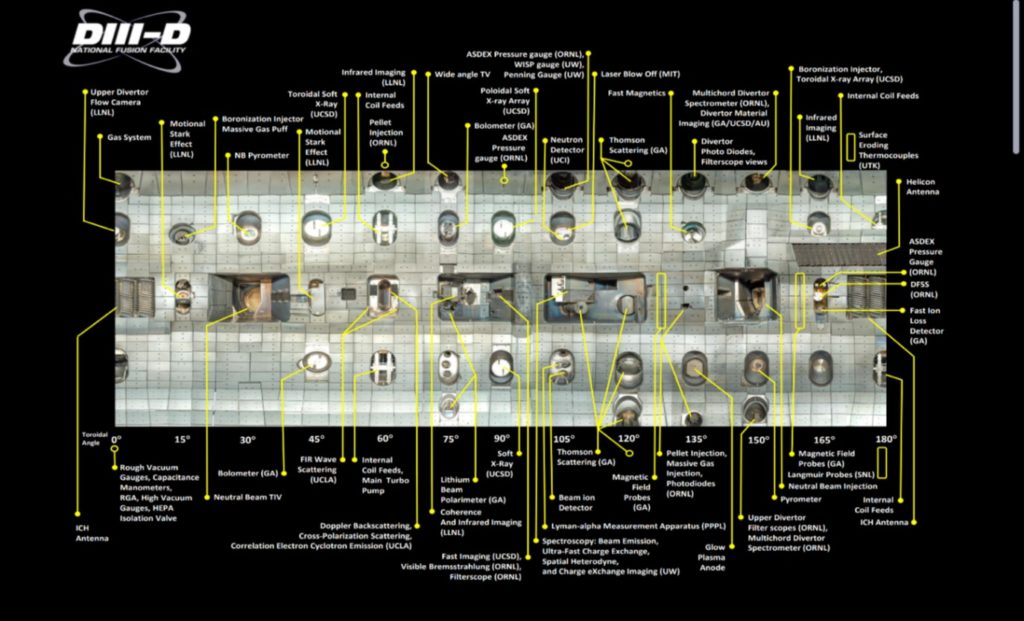
- A large body of research has been conducted to support the design and operation of the ITER project. The research topics include management of transient events using RMPs and the injection of cryogenic pellets at bullet-like speeds, optimization of start-up campaigns, and demonstration of ITER-relevant plasma scenarios.
Today, research in the fusion community continues to build on DIII-D’s rich history and associated scientific advancements. Furthermore, the device itself continues to undergo regular upgrades to ensure that it meets the current and future needs of the community. The DIII-D team continues to pursue important research needed to develop fusion energy as a commercially viable power source.
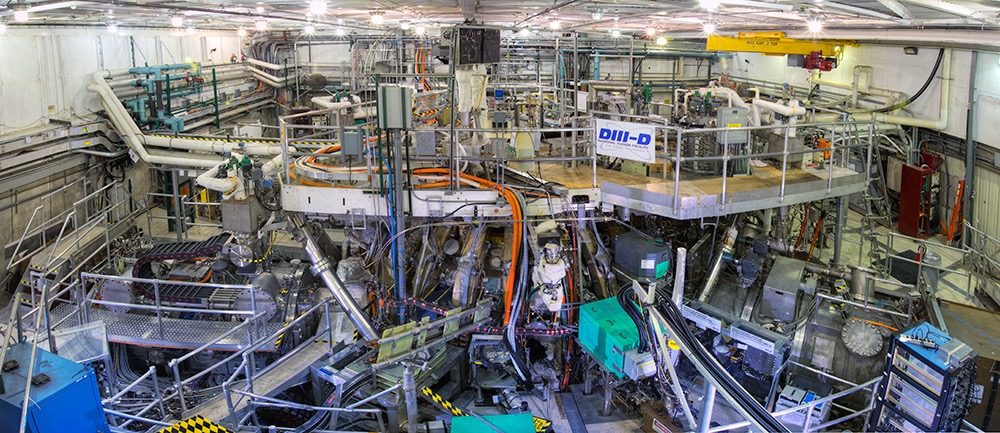
Attributions and Citations
This page is based on contributions from Robert LaHaye, James Luxon, and Keith Burrell, as well as the following webpages, reports, journal articles, and newspaper articles (sorted in chronological order):
Ohkawa, T. & Voorhies H.G. (1969). Plasma-Current Multipole Experiments. Phys. Rev. Lett. 22(24), 1275. https://doi.org/10.1103/PhysRevLett.22.1275
Fishlock, D. (1974, June). General Atomic’s new fusion venture. Nature, 249. https://www.nature.com/articles/249792a0.pdf
Jensen, T.H. et al. (1975). Confinement of Plasma in the Doublet-II Device. Phys. Rev. Lett. 34(5), 257. https://doi.org/10.1103/PhysRevLett.34.257
Ferron, J.R. et al. (1991). An advanced plasma control system for the DIII-D tokamak. Proceedings of the 14th IEEE Symposium on Fusion Engineering (761-764). IEEE. https://www.osti.gov/biblio/10112570
Penaflor, B.G. et al. (2004). Current status of the upgraded DIII-D real-time digital plasma control system. Fus. Eng. Des. 71(1-4), 47-52. https://doi.org/10.1016/j.fusengdes.2004.04.009
Burrell, K.H. et al. (2005). Advances in understanding quiescent H-mode plasmas in DIII-D. Phys. Plas. 12(5), 056121. https://doi.org/10.1063/1.1894745
Leslie, S. (2006, May 23). Interview of Tihiro Ohkawa by Stuart “Bill” Leslie. Niels Bohr Library & Archives. American Institute of Physics, College Park, MD, USA. https://www.aip.org/history-programs/niels-bohr-library/oral-histories/35130
Humphreys, D.A. et al. (2007). Development of ITER-relevant plasma control solutions at DIII-D. Nucl. Fus. 47(8), 943. https://doi.org/10.1088/0029-5515/47/8/028
Evans, T.E. et al. (2008). RMP ELM suppression in DIII-D plasmas with ITER similar shapes and collisionalities. Nucl. Fus. 48(2), 024002. https://doi.org/10.1088/0029-5515/48/2/024002
Penaflor, B.G. et al. (2009). Extending the capabilities of the DIII-D Plasma Control System for worldwide fusion research collaborations. Fus. Eng. Des. 84(7-11) 1484-1487. https://doi.org/10.1016/j.fusengdes.2009.01.034
Chaban, R. (2017, December). Doublet Dudes: Shaping the Future of Fusion. APS News, 26(11). https://www.aps.org/publications/apsnews/201712/backpage.cfm
Buttery, R. et al. (2019). DIII-D Research to Prepare for Steady State Advanced Tokamak Power Plants. J. Fus. Ener. 38, 72-111. https://doi.org/10.1007/s10894-018-0185-y
Burrell, K.H. (2020). Role of sheared E × B flow in self-organized, improved confinement states in magnetized plasmas. Phys. Plas. 27(6), 060501. https://doi.org/10.1063/1.5142734
Buttery, R. et al. (2021). The advanced tokamak path to a compact net electric fusion pilot plant. Nucl. Fus. 61(4), 046028. https://doi.org/10.1088/1741-4326/abe4af
Tamano, T. (2023). General Atomics. Dr. Tihiro Ohkawa. https://fusion-holy-grail.net/general-atomics
General Atomics. (2023). History. https://www.ga.com/history
DIII-D Five-year Research Plan (2019 – 2024), https://fusion.gat.com/global/_media/diii-d/diii-d_5yp_2019-2024_a28765_.pdf
